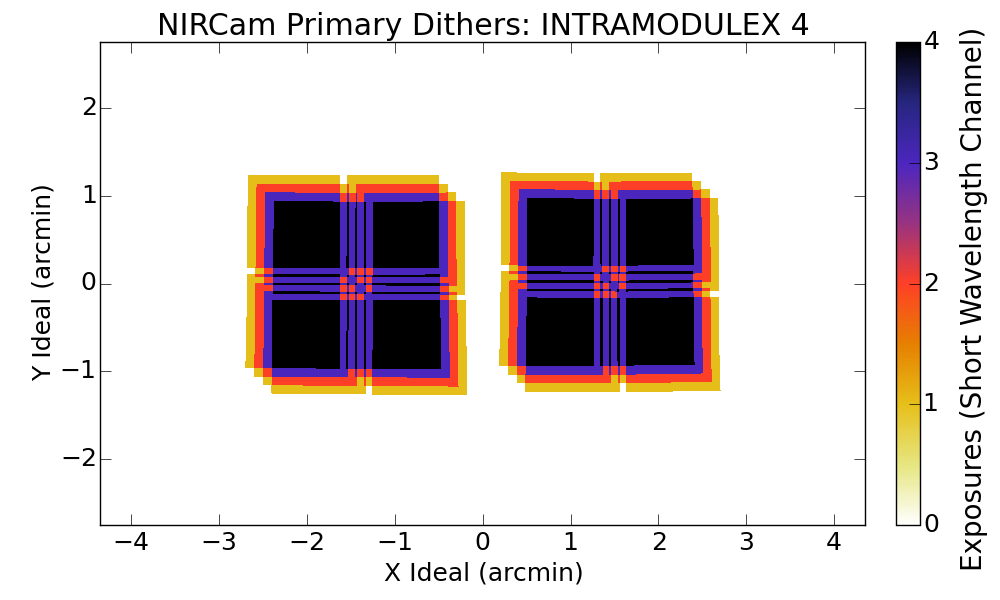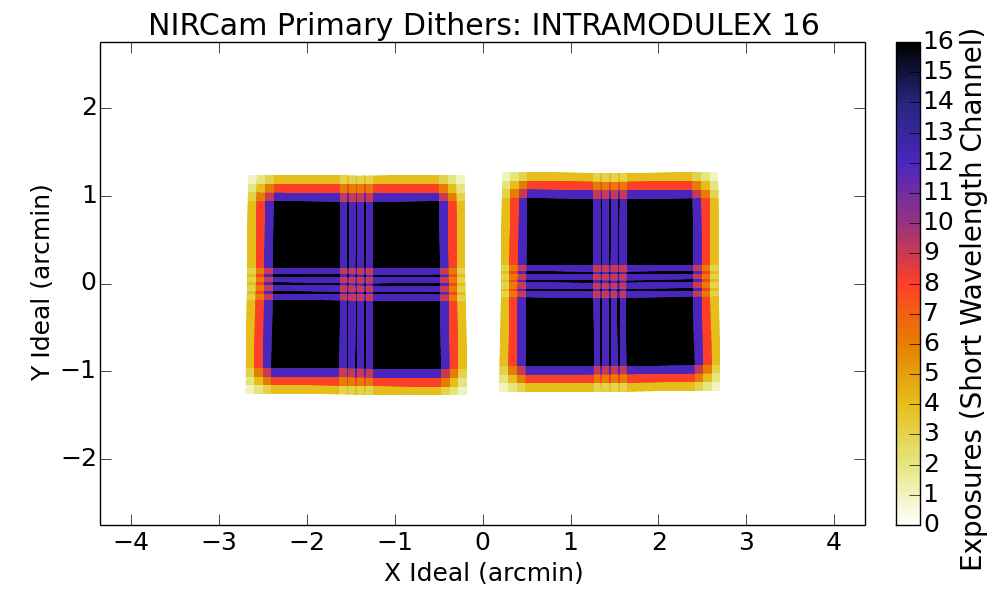NIRCam Primary Dithers
JWST NIRCam primary dither patterns such as FULL, INTRAMODULE, and INTRASCA fill gaps in sky coverage between detectors and mitigate flat field uncertainties.
On this page
Words in bold are GUI menus/
panels or data software packages;
bold italics are buttons in GUI
tools or package parameters.
Primary dithers are best used in conjunction with smaller secondary subpixel dithers, which provide subpixel sampling to improve resolution of the final stacked images. Dithering also mitigates bad pixels and flat field uncertainties by imaging each area of sky with multiple regions of the detectors. Detailed background information on principles of dithered observations with JWST are described in Koekemoer & Lindsay (2005), Anderson (2009), Anderson (2011), Anderson (2014), and Coe (2017).
Most of the FULL dither patterns are designed for use with mosaics to cover larger areas (tens of arcmin² or more) as evenly as possible. The FULLBOX pattern covers all gaps more efficiently (lower slew overheads) but with less even coverage. The "INTRAMODULE" variants and INTRASCA patterns are designed for smaller science targets that fit within a single module or detector, respectively.
There are 3 types of NIRCam primary dither patterns that vary between FULL and INTRAMODULE cases—6 primary dither patterns in total. They are selectable from the Primary Dither Type parameter in APT, each designed with a different goal:
- FULL covers large fields (~10 arcmin²) with both modules, without gaps, and provides roughly even depth of larger areas (>10 arcmin²) when used in conjunction with mosaics.
- FULLBOX is more efficient than FULL, covering a rectangular region without gaps when performing 4 or more dithers.
- INTRAMODULE fills the 4"–5" gaps between short wavelength detectors within one module (~2' × 2' field) or both without covering the gap between modules.
- INTRAMODULEX is similar to INTRAMODULE but more efficient when performing 4 or more dithers.
- INTRAMODULEBOX covers two square regions when performing 4 dithers. It is more compact than INTRAMODULEX, yielding more area with maximal depth.
- INTRASCA mitigates flat field uncertainties by observing small targets (<50" across) in various regions of the detector.
All patterns are available for NIRCam imaging observations. For wide field slitless spectroscopy (WFSS), only the "INTRAMODULE" variants are used.
Examples of these dither patterns are shown in Figures 2–7 as exposure maps, where darker colors indicate greater exposure time. For reference, Figure 1 shows an exposure map without dithers for the short wavelength channel. In Figure 8, the diagonal extents of all patterns are plotted versus visit splitting distances, which is the maximum slew achievable before requiring a new guide star acquisition. (See APT Visit Splitting for more information.)
A complete set of primary and secondary subpixel dither patterns (specified in arcseconds) is available as ASCII tables in the .zip file: NIRCamDitherPatterns.zip
This .zip file contains a collection of separate files for all the NIRCam-related dither patterns. Specifically relevant to the primary dither patterns described in this article, it includes these primary imaging dither patterns (mapping their names to the APT pattern names):
| Filename | APT dither pattern type and pattern name |
|---|---|
| NircamImagingFull.txt | Primary Dither Type: FULL |
| NircamImagingFullBox.txt | Primary Dither Type: FULLBOX |
| NircamImagingIntramodule.txt | Primary Dither Type: INTRAMODULE |
| NircamImagingIntramoduleBox.txt | Primary Dither Type: INTRAMODULEBOX |
| NircamImagingIntramoduleX.txt | Primary Dither Type: INTRAMODULEX |
| NircamImagingIntrasca.txt | Primary Dither Type: INTRASCA |
All pointing offsets are relative to the selected aperture's reference position in that aperture's ideal coordinate frame (X, Y). All NIRCam apertures are nearly aligned (to ~1° of rotation) with both the JWST coordinate system (V2, V3) and all detector rows and columns.
Larger pattern sizes may incur visit splitting and greater observing overheads as discussed below.
FULL dithers and mosaics
Most of the FULL dither patterns are designed for use with mosaics while observing with both modules. They provide roughly even coverage of large areas. Patterns are defined with 3, 6, 9, 15, 21, 27, 36, and 45 pointings (selected from the Primary Dithers parameter in APT). Increasing the number of pointings yields more uniform coverage, approaching a constant depth of ~69% of the exposure time for each pointing. A more compact pattern, 3TIGHT, is designed for use either on its own or in conjunction with a mosaic to provide roughly even coverage of larger rectangular areas.
The large dither steps of these patterns require visit splitting (multiple guide star acquisitions), which increases overheads on observing time. For example, the FULL 3 and FULL 3TIGHT patterns each include 2 horizontal shifts of 58" (116" total).
FULLBOX dithers
The FULLBOX dither patterns are significantly more efficient (lower slew times and overheads) than the FULL patterns. When performing 4 or more dithers, they cover rectangular regions without gaps. The FULLBOX patterns with only 2 or 3 dither positions have the lowest overheads, but they leave gaps. The 6TIGHT pattern may be most efficient given its relatively small maneuvers from one position to the next. The FULLBOX "TIGHT" patterns are generally more efficient and compact; wider patterns are available for 4, 6, and 8 dither positions. The 8NIRSPEC pattern is designed to cover a 6' × 5' region large enough for NIRSpec pre-imaging.
INTRAMODULE dithers
The INTRAMODULE dither pattern is smaller, consisting of a 4 × 4 grid of 16 pointings that are 22.5" across. This covers the short wavelength detector gaps, but not the ~43" gap between modules. Only one guide star is required for most targets, reducing overheads. Users can select numbers of dither positions between 2 and 16 for this pattern. Figure 4 shows 2 examples. Note that small regions at the center of each module have significantly lower integration times than their surroundings (1/3 and 9/16 of the totals in these examples).
INTRAMODULEX dithers
The INTRAMODULEX pattern is very similar to the INTRAMODULE pattern but more efficient (lower slew times and overheads) when performing 4 or more dither positions. It is slightly more compact, and the positions are reordered for efficiency.
INTRAMODULEBOX dithers
The INTRAMODULEBOX pattern is more compact than INTRAMODULE or INTRAMODULEX. This yields more area observed at full depth. It is designed primarily to cover 2 square regions (one for each module) without gaps when performing 4 dither positions.
INTRASCA dithers
TheINTRASCA dither patterns are designed for science targets smaller than the 64" × 64" field of view of a single short wavelength detector, or SCA. The goal is to mitigate flat field uncertainties by moving the target's image to all edges and corners of the detector.
The full pattern consists of a 5 × 5 grid of 25 pointings and comes in 3 sizes (selected in the Dither Size APT parameter): 8" (SMALL), 16" (MEDIUM), and 24" (LARGE). The nominal dimensions give the approximate half widths of each full pattern. The smallest patterns can observe larger science targets in all exposures, and vice versa. For example, the 8" (SMALL) pattern is 16.38" across, allowing a target 47" across (or smaller) to fit within a short wavelength detector (64" across) in all 25 exposures. The 24" (LARGE) pattern can do the same for targets just 15" across (or smaller).
The INTRASCA dither pattern sizes are all smaller than the FULL pattern. The INTRAMODULE pattern size (22.5" across) is between the INTRASCA 8" (SMALL) and INTRASCA 16" (MEDIUM) pattern sizes.
Table 1. INTRASCA dither pattern sizes
Dither size | Full pattern width | Science target width | Pattern diagonal extent |
|---|---|---|---|
| 8" (SMALL) | 16.38" | <47" | 23" |
| 16" (MEDIUM) | 32.76" | <31" | 46" |
| 24" (LARGE) | 49.12" | <15" | 69" |
Each pattern's name includes the approximate half-width of the full pattern. If the science target width is less than 64" minus the pattern width, then it will fit within a short wavelength detector in all exposures. The diagonal extent of the pattern (width × √2) determines whether multiple visits will be required, increasing overheads.
Pattern sizes and visit splitting
Compact dither patterns may be executed in a single visit with a single guide star. Wider dither patterns may require multiple visits with multiple guide stars, adding overhead time for guide star acquisitions. The maximum distance allowed between pointings in a single visit is a function of Galactic latitude for fixed targets and 30" for all moving targets. These distances were determined based on statistical analysis of guide star availability using observing programs in the Science Operations Design Reference Mission (SODRM). Figure 8 shows this visit splitting distance along with the diagonal extent of each NIRCam primary dither pattern.
The INTRAMODULEBOX, INTRAMODULEX, and INTRASCA8" (SMALL) patterns may always be executed within a single visit. The same is usually true for the INTRAMODULE pattern. Larger INTRASCA patterns require visit splitting for some targets. FULL patterns always require multiple visits. The FULLBOX patterns may be executed within a single visit if the visit splitting distance is 50" (55") or greater for the "TIGHT" (wider) patterns.
References
Anderson, J. 2009, JWST-STScI-001738
Dither Patterns for NIRCam Imaging
Anderson, J. 2011, JWST-STScI-002199
NIRCam Dithering Strategies I: A Least Squares Approach to Image Combination
Anderson, J., 2014, JWST-STScI-002473
NIRCam Dithering Strategies II: Primaries, Secondaries, and Sampling
Coe, D. 2017, JWST-STScI-005798
More Efficient NIRCam Dither Patterns
Koekemoer, A. M. & Lindsay, K. 2005, JWST-STScI-000647
An Investigation of Optimal Dither Strategies for JWST













